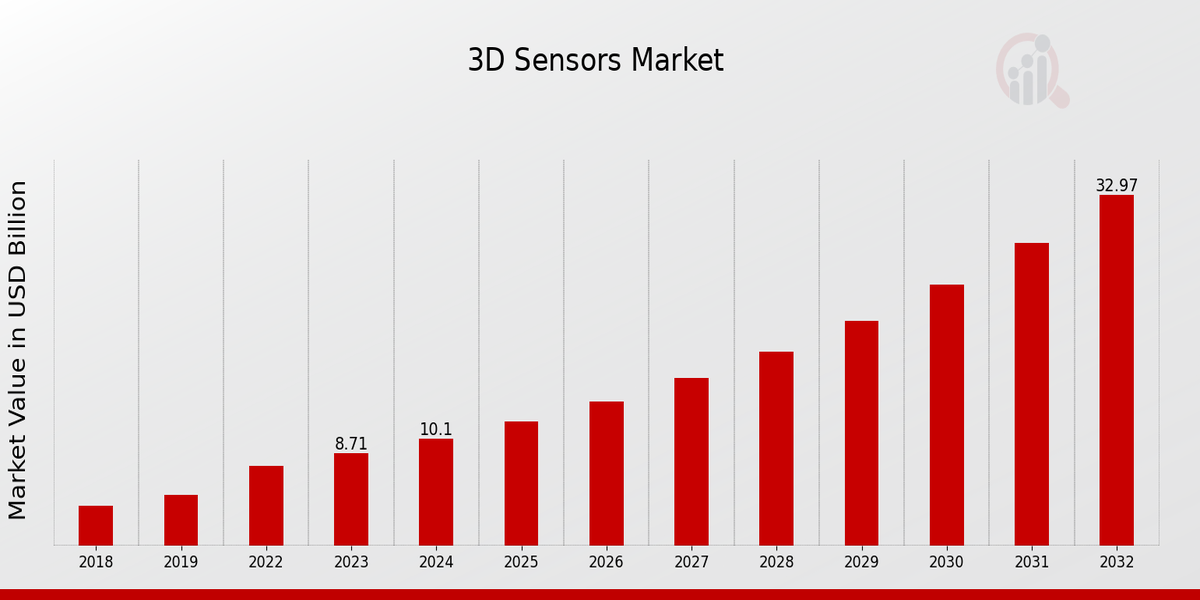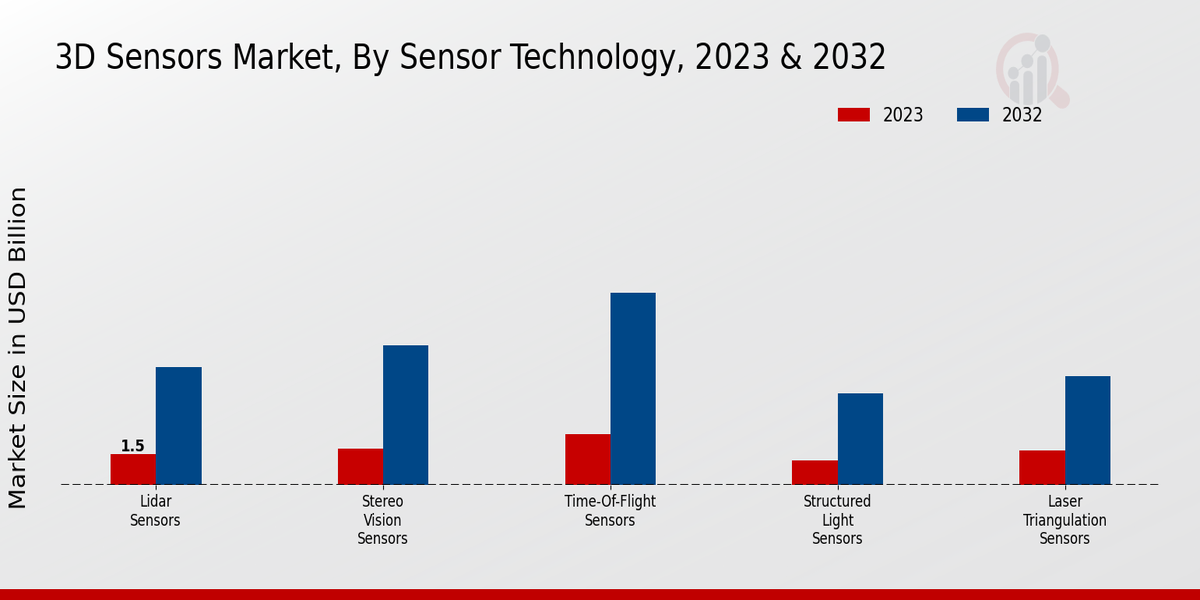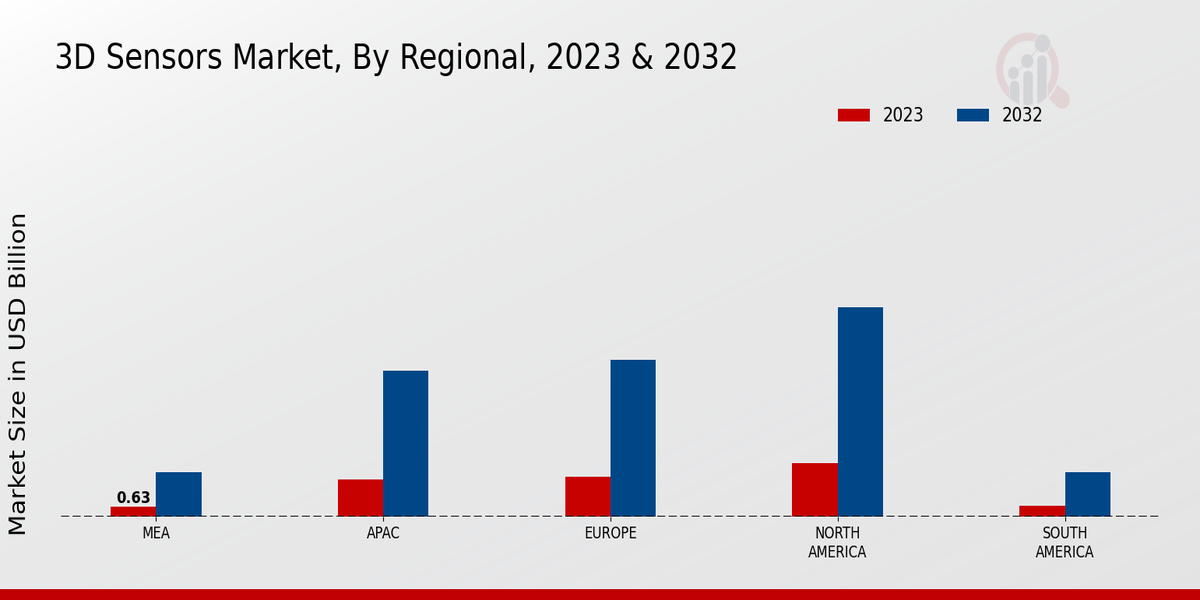No infographic available
Kindly complete the form below to receive a free sample of this Report
3D Sensors Market Size was estimated at 7.51 (USD Billion) in 2022. The 3D Sensors Market Industry is expected to grow from 8.71(USD Billion) in 2023 to 32.98 (USD Billion) by 2032. The 3D Sensors Market CAGR (growth rate) is expected to be around 15.94% during the forecast period (2024 - 2032).
Key 3D Sensors Market Trends Highlighted
The 3D Sensors Market is significantly influenced by advancements in technology and increasing adoption across various sectors. Key market drivers include the growing demand for enhanced imaging and sensing capabilities in consumer electronics, automotive, and healthcare applications. The proliferation of augmented reality (AR) and virtual reality (VR) technologies has further propelled the need for 3D sensors, as they provide essential depth perception and spatial awareness. The adoption of these sensors in robotics and automation also highlights their crucial role in improving operational efficiency and safety across manufacturing and logistics industries.
With the ongoing push towards automation and smart technologies, there are ample opportunities for innovation within the 3D sensors space. The integration of artificial intelligence (AI) with 3D sensing technologies is one of the promising avenues that can enhance data processing and interpretation, leading to improved decision-making in real-time applications. Moreover, emerging markets present a fertile ground for growth, as various industries seek to modernize their operations and leverage advanced sensing solutions to stay competitive.
In recent times, there has been a noticeable trend towards miniaturization of 3D sensors, making them more versatile for use in compact devices like smartphones and wearables. The convergence of various sensing technologies into unified systems is also gaining traction, providing increasingly sophisticated solutions that cater to diverse applications. As industries continue to prioritize digital transformation and enhanced user experiences, the global landscape for 3D sensors will likely evolve, driven by innovation and the expanding capabilities of these technologies.

Source: Primary Research, Secondary Research, MRFR Database and Analyst Review
3D Sensors Market Drivers
Increasing Adoption of 3D Imaging Technology
The globalization of 3D imaging technology has sparked a transformative wave across various industries. This shift is driven primarily by the burgeoning demand for enhanced accuracy and precision in diverse applications, including automotive, healthcare, and industrial automation. As sectors increasingly prioritize automation and data accuracy, the 3D Sensors Market Industry is experiencing a rapid uptick in the adoption of advanced 3D imaging systems.Companies are leveraging the capability of these sensors to adapt to industry-specific challenges, resulting in remarkable productivity improvements and innovative product designs. Furthermore, the integration of 3D sensors with technologies such as artificial intelligence (AI) and machine learning is opening new avenues for data interpretation and utilization. This seamless convergence enhances machine vision systems, enabling real-time quality inspection and reducing operational costs, ultimately offering competitive advantages in the marketplace.Additionally, the ongoing advancements in sensor technology, spurred by investments in research and development, are leading to the creation of smaller, more sensitive, and higher-resolution sensors. These developments ensure a broader application range across sectors, solidifying their crucial role in the 3D Sensors Market Industry. As industries adapt to meet consumer expectations for enhanced user experiences, the pressing need for sophisticated 3D sensing solutions is set to accelerate, ensuring robust market growth in the years to come.
Growth of Virtual and Augmented Reality
The rise of virtual reality (VR) and augmented reality (AR) technologies is significantly influencing the 3D Sensors Market Industry. With their increasing integration into gaming, entertainment, and training applications, there is a heightened demand for effective 3D sensors capable of producing accurate depth information. These advanced sensors play a pivotal role in creating immersive experiences by accurately tracking user movements and adapting virtual environments in real time.As industries recognize the transformative potential of VR and AR, investments continue to surge, driving the expansion of the 3D sensors market.
Advancements in Robotics
The relentless advancements in robotics are propelling growth in the 3D Sensors Market Industry. Robotics applications in sectors such as manufacturing, logistics, and healthcare rely heavily on high-performance 3D sensors for navigation, object detection, and precise mapping. The increasing reliance on automation and smart robotics solutions necessitates advanced sensing technologies, driving innovation and market demand.
3D Sensors Market Segment Insights:
3D Sensors Market Sensor Technology Insights
The 3D Sensors Market is witnessing robust growth, particularly within the Sensor Technology segment, which encompasses various innovative sensing technologies that are crucial for capturing three-dimensional data. As of 2023, the overall market is valued at 8.71 USD Billion and is projected to grow substantially to 32.98 USD Billion by 2032. Each component within this segment contributes uniquely to the market, demonstrating varying degrees of significance and growth potential. Time-of-Flight Sensors, valued at 2.5 USD Billion in 2023, play a pivotal role in applications like gesture recognition, robotics, and autonomous vehicles, relying on the time it takes for light to travel to an object and back. Looking at Lidar Sensors, which are set at 1.5 USD Billion for the same year, they are vital for mapping and navigation in industries such as automotive and surveying, thanks to their precise distance measurement capabilities, which directly contribute to their majority holding in the market relative to other sensor types.
Stereo Vision Sensors, valued at 1.8 USD Billion in 2023, enable depth perception similarly to human vision and are integral in fields such as augmented reality and machine vision, making them significantly influential in enhancing user experiences. Structured Light Sensors, with a valuation of 1.2 USD Billion, leverage light patterns to quantify changes in dimensions, and their application in 3D scanning and inspection processes accentuate their importance in manufacturing and quality control. Additionally, Laser Triangulation Sensors, valued at 1.71 USD Billion, are essential in precision measurement and automation processes, making them significant in environments where exactness is crucial. Each of these sensor types reflects distinct features and applications, ensuring diverse functionalities across industries, from consumer electronics to industrial automation, further emphasizing the dynamic nature and continuous evolution of the 3D Sensors Market. Market growth is driven by increasing demand for automation and smart technologies, while challenges such as high costs of implementation persist; nevertheless, growing opportunities in the realm of virtual reality and industrial applications steer the market toward favorable trends and promising advancements.

Source: Primary Research, Secondary Research, MRFR Database and Analyst Review
3D Sensors Market Application Insights
The 3D Sensors Market is projected to experience significant growth, with the overall market valued at 8.71 USD Billion in 2023, and expected to expand in various applications across multiple industries. The Application segment comprises Consumer Electronics, which remains critical due to the increasing adoption of smart devices. The Automotive industry is witnessing a transformation, leveraging 3D sensors for enhanced safety and driver assistance systems. In Healthcare, 3D sensors are gaining traction, particularly in medical imaging and surgical procedures, improving outcomes and precision.Industrial Automation benefits from 3D sensors through improved manufacturing processes and quality control, leading to enhanced operational efficiency. Robotics is emerging as a prominent area, where 3D sensors facilitate navigation and manipulation, resulting in advanced robotic solutions. With these diverse applications, the 3D Sensors Market segmentation reveals opportunities driven by technological advancements and growing demand for automation across sectors, further enhancing the market growth. Overall, the landscape is shaped by the evolving needs of these industries, presenting a promising avenue for innovation and development as the industry progresses through 2032.
3D Sensors Market Sales Channel Insights
The 3D Sensors Market, valued at 8.71 USD Billion in 2023, showcases a thriving Sales Channel segmentation that includes Direct Sales, Distributors and Resellers, Online Sales, and Retail Stores. Each of these channels plays a pivotal role in driving revenue and accessibility for 3D sensors. Direct Sales often lead to personalized customer relationships, enabling companies to cater specifically to client needs. Alternatively, Distributors and Resellers help widen market reach, allowing for a vast distribution network that is vital for catering to diverse markets.Online Sales have gained significant traction, bolstered by an increase in e-commerce, making it easier for consumers to access advanced technology. Retail Stores continue to play an important role for customers who prefer physical product interactions, ensuring users can experience the technology first-hand. Overall, the 3D Sensors Market data reflects that these sales channels are crucial for maximizing market potentials, aligning with the market growth driven by advancements in technology and increased demand across various industries.
3D Sensors Market End User Industry Insights
The 3D Sensors Market, valued at 8.71 billion USD in 2023, showcases significant momentum across various end user industries, driving advancements in technology and application. Each industry utilizes 3D sensors uniquely, contributing to the overall market growth. The aerospace sector leverages these sensors for precision engineering and enhanced safety measures, while the construction industry utilizes them for efficient project management and accurate measurements. Manufacturing benefits from increased automation and quality control through 3D sensing technologies.In healthcare, 3D sensors play a crucial role in imaging and surgery, improving patient outcomes. The entertainment industry uses them to create immersive experiences, enhancing user engagement. This diverse application portfolio underlines the substantial significance of the sectors in the 3D Sensors Market segmentation, fueling demand and innovation across the board. Furthermore, growing trends such as miniaturization and enhanced accuracy in sensor design propel the market forward, creating opportunities for growth amidst evolving technological landscapes.While the market showcases opportunities, it must also navigate challenges like maintaining data security and dealing with high production costs, which can impact overall growth.
3D Sensors Market Form Factor Insights
The 3D Sensors Market is expected to reach a valuation of 8.71 USD Billion in 2023, showcasing strong growth in the form factor segment. This segment reveals a diverse array of sensor configurations, including Camera-based 3D Sensors, Standalone 3D Sensors, and Integrated 3D Sensors, each playing a vital role in various applications. Camera-based 3D Sensors remain prominent due to their versatility and ability to capture high-resolution images, facilitating advancements in industries like gaming, automotive, and healthcare. Standalone 3D Sensors, valued for their independence from other devices, cater to specialized applications requiring dedicated processing capabilities, while Integrated 3D Sensors, designed to be seamlessly embedded into existing systems, are increasingly adopted for their compact nature and efficiency.The growing demand for automation and robotics, coupled with innovations in these sensor types, continues to drive market growth. Furthermore, the expanding applications in augmented and virtual reality sectors highlight the significance of this segment within the broader 3D Sensors Market landscape. As trends like smart technology integration evolve, the form factor segment is well-positioned to capitalize on emerging opportunities, reinforcing the overall market trajectory.
3D Sensors Market Regional Insights
The 3D Sensors Market is poised for substantial growth over the coming years, with a significant focus on regional dynamics. In 2023, North America leads the market with a valuation of 3.41 USD Billion, reflecting its majority holding due to advanced technological adoption and a thriving industrial base. Europe follows with a valuation of 2.56 USD Billion, driven by substantial investments in automation and smart technologies, demonstrating its significance in the global landscape. The Asia Pacific region, valued at 2.38 USD Billion, is rapidly expanding, fueled by rising demand for electronics and automotive applications, making it a critical area for market growth.The Middle East and Africa region stands at 0.63 USD Billion, showing promising growth potential as industries increasingly adopt digital solutions. South America is valued at 0.73 USD Billion, indicating its nascent stage in 3D sensor application yet hints at emerging opportunities. Each region's growth trajectory showcases diverse applications and technological advancements, influenced by local industry demands and investment activities, marking a dynamic landscape in the 3D Sensors Market industry.

Source: Primary Research, Secondary Research, MRFR Database and Analyst Review
3D Sensors Market Key Players And Competitive Insights:
The 3D Sensors Market has been witnessing rapid advancements fueled by the growing demand for innovative technologies across various sectors such as consumer electronics, automotive, and healthcare. This market is characterized by a landscape of intense competition where companies are striving to leverage cutting-edge technologies and develop solutions that cater to the evolving needs of consumers and industries alike. Key players are investing substantially in research and development to enhance the capabilities of their products, utilizing techniques such as time-of-flight, structured light, and stereo vision to ensure high precision and accuracy in 3D sensing applications. The increasing adoption of augmented reality and virtual reality has further accelerated growth in this market, positioning it as a critical component in both consumer and industrial domains.Oculus VR has established itself as a significant player in the 3D Sensors Market. The company is well-known for its innovative contributions to virtual reality technologies, where 3D sensors play an essential role in creating immersive experiences. Oculus VR's strengths lie in its strong brand recognition and the high-quality performance of its products, which are enhanced by sophisticated 3D sensing capabilities. The firm’s focus on user experience, coupled with state-of-the-art sensor technology, enables it to deliver seamless interaction and engagement for users in virtual environments. By continuously investing in advancements in optical sensing and computer vision, Oculus VR is strategically positioned to maintain a competitive edge in a rapidly growing marketplace, asserting its presence through premium offerings that elevate the virtual reality experience.Parrot SA, another notable entity in the 3D Sensors Market, specializes in the development and manufacture of drones and related technologies that utilize 3D sensing capabilities. The company's innovative use of 3D sensors allows for enhanced aerial imaging and mapping applications, significantly benefiting various industries such as agriculture, construction, and surveying. Parrot SA's overarching strength lies in its ability to integrate advanced sensor technologies into its drone systems, providing users with unrivaled data accuracy and functional versatility in the field. The company’s dedication to creating high-performance drones with rich sensor capabilities has created advantageous market positioning. Through continuous innovation in UAV technology and the application of 3D sensing, Parrot SA is carving out a substantial niche for itself within this competitive market, appealing to professional users who require precision and adaptability in their operations.
Key Companies in the 3D Sensors Market Include:
Oculus VR
Parrot SA
Microsoft
Lattice Semiconductor
Basler AG
Cognex Corporation
Hamamatsu Photonics
Texas Instruments
Apple
Intel Corporation
Analog Devices
ASUS
Sony
3D Sensors Industry Developments
Recent developments in the 3D Sensors Market underscore its rapid growth and technological advancements. Key industries, including automotive, healthcare, and consumer electronics, are increasingly adopting 3D sensors for applications like autonomous driving, medical imaging, and augmented reality. Notable partnerships and collaborations among leading companies are driving innovation, with firms focusing on enhancing sensor accuracy and reducing costs. Additionally, advancements in sensor technology, such as the integration of artificial intelligence and machine learning, are enabling improved data processing and object recognition capabilities. Furthermore, the surge in demand for smart devices and systems has prompted manufacturers to explore miniaturization and energy efficiency. Regulatory efforts aiming to standardize safety measures for technologies like driverless cars are also influencing market dynamics. The ongoing exploration of applications in virtual reality and gaming is further stimulating interest in 3D sensors, making them a critical component in the evolution of interactive and immersive experiences. As industries continue to invest in advanced technologies, the 3D sensors market is poised for significant advancements and expansions in the coming years.
3D Sensors Market Segmentation Insights
3D Sensors Market Sensor Technology Outlook
3D Sensors Market Application Outlook
3D Sensors Market Sales Channel Outlook
3D Sensors Market End User Industry Outlook
3D Sensors Market Form Factor Outlook
3D Sensors Market Regional Outlook
No infographic available
Kindly complete the form below to receive a free sample of this Report
“I am very pleased with how market segments have been defined in a relevant way for my purposes (such as "Portable Freezers & refrigerators" and "last-mile"). In general the report is well structured. Thanks very much for your efforts.”